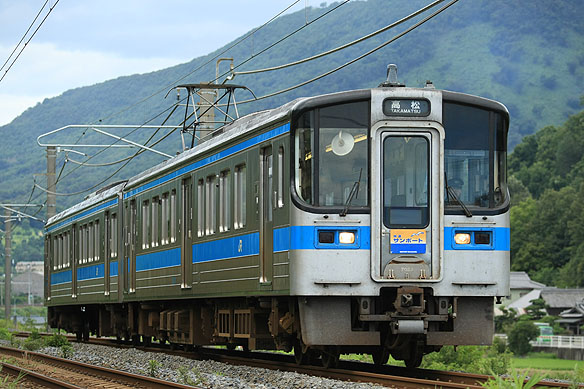7000 series are electric multiple unit (EMU) train type developed by JR
Shikoku for the start of rural services of the newly electrified Yosan
line around Matsuyama in 1990.
The fleet consists of double-ended motored cars, type 7000, and single-ended
trailer cars, type 7100. The ticket machine, which put the ticket indicates
the boarding station, is located at the boarding doors. The fare display
and the fare box are located behind the motorman's cab.
The vehicle design incorporates light-weight stain-less steel construction.
The height of the body is limited to 3565mm in order to run through the
narrow tunnels between Minoura and to the west. The centre slide doors
are double leaf, and the other slide doors are single leaf. Under conductor-less
operation, the centre doors are closed. All cars are equipped with the
automatic jumper coupler in order to couple/uncouple formations easily.
The bogies use a bolster-less design based on the standard 205 series EMU
bogies, designated S-DT58 for the motored cars, and S-TR58 for the trailer
cars.
The traction motors, rated at 120kW, are controlled by AVAF inverter traction
systems featuring GTO thyristor. Because of the variable ratio of motored
cars among the formation, 7000 series have cutoff current select switch
in order to keep the same acceleration performance. Although the electric
command brake system incorporates the regenerative braking, the brake controller
controls the pneumatic brake of each car with the required pneumatic braking
force in order to prevent generating regenerative invalidation.
Seating accommodation consists of longitudinal bench seating on one side and transverse seating on the other side of each car, in a similar style to the JR Shikoku 1000 series DMU. Ventilators are discontinued for the cost reduction.
Now 7000 series EMU are used on the rural services around Matsuyama in
Shikoku. |
|

